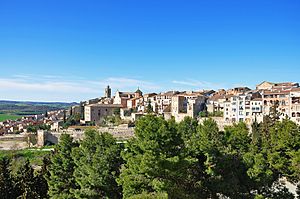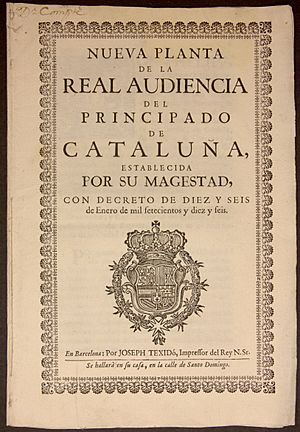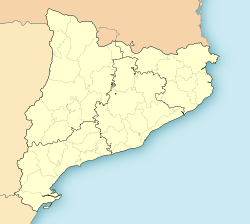Cervera facts for kids
Quick facts for kids
Cervera
|
|||
|---|---|---|---|
|
Municipality
|
|||

Cervera
|
|||
|
|||
| Country | |||
| Community | |||
| Province | Lleida | ||
| Comarca | Segarra | ||
| Area | |||
| • Total | 55.2 km2 (21.3 sq mi) | ||
| Elevation | 548 m (1,798 ft) | ||
| Population
(2018)
|
|||
| • Total | 9,066 | ||
| • Density | 164.24/km2 (425.4/sq mi) | ||
| Demonyms | Cerverí, cerverina | ||
| Postal code |
25200
|
||
| Climate | Cfb | ||
Cervera is a cool city in Catalonia, Spain. It's the main town of a region called Segarra, which is part of the province of Lleida.
Did you know that a special royal title, the Count of Cervera, is now used by Leonor, Princess of Asturias? She's the future queen of Spain!
Cervera is also famous for being the hometown of the amazing Márquez brothers. Marc Márquez and Álex Márquez are both world champions in Grand Prix motorcycle racing. The old church of Sant Miquel de Tudela is also close by.
Contents
History of Cervera
Early Beginnings and Medieval Growth
Cervera started way back in the year 1026. Three families built the very first homes in the Segarra area. At that time, this land was empty.
The counts of Barcelona then gave these families ownership of the land. They wanted to make their power stronger in this area. This was important because Segarra was a border between Christian and Muslim lands. So, the first fortress, called castrum Cervarie, was built.
In 1149, the border moved further west to Lleida. After this, Cervera started to grow a lot. People built homes closer together, like terraced houses.
The people of Cervera gained more freedom from their local lords. They also got special rights from the king. This helped the town grow into a strong community. First, it became a Confraria (a group of people working together) in 1182. Then, it became a Consolat (a local government) in 1202. Since 1267, it has been known as a Paeria, which is another type of local government.
A very important event happened in 1452. The future King Ferdinand II of Aragon and Queen Isabella I of Castile signed their marriage agreement here. They are known as the Spanish Catholic Monarchs.
Cervera also had a thriving Jewish community for many years. They lived there from the 12th century until the Jews were asked to leave Spain in the 15th century.
In 1702, King Philip V gave Cervera the special title of "city." The people of Cervera were very thankful. They had shown strong support for the king's plans, especially during a war.
The Famous University of Cervera

In 1700, Charles II, the last king from the House of Austria, passed away. He chose Philip V as the next king. Philip V was accepted in most of Spain.
However, some countries, like England, wanted Charles VI to be the king. This led to a big European war in 1702, called the War of the Spanish Succession. During this war, people in Cervera supported both sides.
After the war, Cervera was badly damaged. The town decided to support the new rulers, the Bourbons. They sent two representatives to the king. Their goal was to show their full support for King Philip V.
They hoped to get something good in return. One of their 30 requests was to have a university, just like the one in Lleida. King Philip V agreed! He built the University of Cervera. He also closed other universities in Catalonia with the Nueva Planta decrees.
Having the university brought a big boost to Cervera's economy. Many students came to live in the town, which helped local businesses.
Changes and Challenges
In 1842, the University of Cervera moved to Barcelona. This was a big economic loss for the town.
However, things started to get better. In 1860, the train arrived in Cervera. Public services, like the water supply, also improved. New industries started, and there was a strong wine trade. All these things helped the local economy grow again.
Later, a plant disease called Phylloxera hit the vineyards. This caused many people who grew grapes to lose their businesses. It was a major crisis for Cervera's wine trade. But the town recovered a bit when the Sindicat Agrícola (an agricultural union) was created in 1919.
See also
 In Spanish: Cervera para niños
In Spanish: Cervera para niños




